Most of the time I was able to take the time to resist the temptation to blindly prescribe whatever treatment my patient saw on TV the night before, but it did take time. As I have often proclaimed in this column, it only takes two minutes to write a prescription, whereas it takes 20 minutes to not write one (a bunch of teaching and some arguing is required). But when time is money and medicine is a for-profit venture, one can predict what the average clinic administrator (and too many physicians) will choose to do. And therein lies one of the biggest problems in the for-profit medical (non-) system in America.
Being a physician, I had a certain amount of power to influence my patients to view with suspicion the latest fad drug. But more often than I care to admit, I found that I had also been the victim of deceptions and myths that my friendly - and very cunning - pharmaceutical salesperson wanted me to believe.
One of the most serious myths that I had to unlearn over the decades was the one that my academic (as opposed to clinical) medical professors had taught me about the "fact" that vaccines were entirely safe and entirely effective and were the reasons that measles, mumps, chickenpox and polio had virtually disappeared.
It was only after I had personally heard the many stories from the parents of vaccine-damaged children that I found the time to search the literature and find out more about the dangers and relative ineffectiveness of the vaccines that I once had prescribed. I never was led to believe that there was any reason for skepticism. In retrospect, I regard myself as being fortunate that I had already stopped seeing pediatric patients prior to the era when the various Big Pharma and Big Vaccine corporations (and their lapdog lobbying and trade organizations like the AMA, the AAFP and the AAP) were pushing dozens of new vaccines onto an unsuspecting public.
I was no different than most other healthcare givers in America in being relatively unaware of the dangers behind the escalating numbers of untested-for-safety inoculations that most family docs and pediatricians routinely prescribed for healthy (and even unhealthy!) kids. It wasn't until the autism epidemic graph was found to be rising in parallel with the vaccine epidemic graph that I understood the obvious correlation between the two phenomena. There was no better answer to the question that the medical profession and Big Pharma consistently glossed over, tried to ignore and then irrationally tried to obfuscate: "what could be causing the astonishing and very sudden rise in the appearance of autism spectrum disordered kids?"
Here is the obvious answer to that question: It was the rapidly increasing numbers and combinations of known-to-be neurotoxic vaccines (as many as 9 antigens at one sitting into 2, 4 and 6 month well-babies!) that were being aggressively formulated, manufactured, aggressively marketed and then cavalierly injected into innocent babies, starting with the Reagan administration 's passage of a law that made it illegal for parents to sue vaccine companies or doctors when their little children suffered vaccine-related deaths or injuries from the combinations of vaccines that had never been tested for safety or even long-term effectiveness.
What made the connections between the shots and the resultant brain damage and autoimmunity so obvious was the fact that those intramuscularly-injected vaccines contained either 1) live viruses, some of which were known by the manufacturers (but not by the pediatricians or parents) to be capable of causing encephalitis (and therefore permanent brain damage), 2) mercury (thimerosal) which is known to cause the death of any cell it comes in contact with, especially liver, brain and nerve cells, and/or 3) aluminum which is known to cause brain damage, hyper-immunity and thus autoimmune disorders (which is now causing the American epidemic of childhood autoimmune disorders, an entirely new phenomenon that has no other logical explanation. Hereditary or genetics has nothing to do with either phenomenon.
Neither my drug reps nor my professors ever bothered to tell me what ingredients were in the baby shots. They maybe didn't know themselves. They certainly didn't tell me that there were intentionally-added metallic neurotoxins in the shots. They never informed me that the carcinogen formaldehyde was in many of the shots. They never informed me that a cancer-causing monkey virus (SV 40 - simian virus 40) was in one of the early Salk polio vaccines - still causing malignancies decades later! They never told me that the mercury and aluminum in the shots were accumulative (and synergistic!) nor that both metals could easily get into the brain and damage our mitochondria and cause brain toxicity, epilepsy, learning disorders, inattention, early deaths - and autism.
At any rate, in my wide reading and extensive research into the basic neuroscience of vaccines, I have acquired the science that I needed in order to understand exactly what my vaccine-damaged patients, relatives and acquaintances have gone through. Although it may be too late for them to benefit from the truth about vaccines, I do wish that I had known about those realities when I was practicing medicine, and I hope that I can belatedly shine some light on this important subject for that similar fates will be avoided for others. It might atone for some of the damage that I might have done to patients because of the many medical myths taught to me by my professors.
So I yield the remainder of this article to an important summary of the history of vaccinations written by a highly esteemed physician colleague of mine - and a fellow whistle-blower, Dr Suzanne Humphries, one of the most knowledgeable physicians on the subject of vaccines that I have ever encountered.
Dr Humphries co-authored an important book on the history of vaccines with Roman Bystrianyk. It is titled Dissolving Illusions: Disease, Vaccines, and The Forgotten History. Check our www.dissolvingillusions.com for much more, and spend an hour or two watching some of Dr Humphries powerful lectures about the science of vaccines, information that you wish your kid's physicians would try to understand. Dr Humphries is one of the many featured scholars and experts on vaccine dangers on the powerful new 7-part documentary series that is entitled The Truth About Vaccines. The first episode of that series can be viewed for free at https://go2.thetruthaboutvaccines.com/docuseries/replay/.
---------------------------------------------------------------------------------------
Vaccines: A Peek Beneath the Hood
By Roman Bystrianyk and Suzanne Humphries, MD
Co-authors of Dissolving Illusions: Disease, Vaccines, and The Forgotten History
Originally published on the website of the International Medical Council on Vaccination
"It is dangerous to let the public behind the scenes. They are easily disillusioned and then they are angry with you, for it was the illusion they loved."
- W. Somerset Maugham
Medical history books, almost uniformly extol the virtues of vaccination. Upon reading these books, one is left with the impression that during the 1800s and into the 1900s, there were rampant plagues that killed countless scores of people and that, because of vaccines, this is no longer the case. This is certainly what we believed growing up, and most people we talk to have a similar impression. It generally permeates society as an established fact.
It is difficult to underestimate the contribution of immunization to our well-being. It has been estimated that, were it not for childhood vaccinations against diphtheria, pertussis, measles, mumps, smallpox, and rubella, as well as protection afforded by vaccines against tetanus, cholera, yellow fever, polio, influenza, hepatitis B, bacterial pneumonia, and rabies, childhood death rates would probably hover in the range of 20 to 50%. Indeed, in countries where vaccination is not practiced, the death rates among infants and young children remain at that level. [1]Paul Offit talks in his recent book Deadly Choices—How the Anti-Vaccine Movement Threatens Us All about how the whooping cough vaccine has reduced deaths from that disease from 7,000 to only 30.
Whooping cough (pertussis) is a devastating infection. Before a vaccine was first used in the United States in the 1940s, about three hundred thousand cases of whooping cough caused seven thousand deaths every year, almost all in young children. Now, because of the pertussis vaccine, fewer than thirty children die every year from the disease. But times are changing. [2]This type of information can even be found in medical journals. A lengthy study on whooping cough and the whooping cough vaccine was published in 1988 in the journal Pediatrics. The first paragraph of the paper states the following:
In the United States, pertussis has been successfully controlled by routine mass immunization of infants and children. In the pre-vaccine era, there were 115,000 to 270,000 cases of pertussis and 5,000 to 10,000 deaths due to the disease each year. During the last 10 years, there have been 1,200 to 4,000 cases and five to ten deaths per year. [3]That paragraph set the tone for the rest of the article by indicating that thousands of people died each year from whooping cough, but after the DTP vaccine was introduced, very few died. Anyone who believed this statement would, of course, believe in the benefit of the vaccine.
The problem with these statements is that they are not supported by the evidence. When we look at the actual data, we see that although many people did die from whooping cough in the early part of the 1900s, by the time the vaccine had been introduced the death rate in the United States had declined by more than 90 percent. Using the source that was referenced to make the statement in the Pediatrics paper, we see that the decline in deaths from the peak was approximately 92 percent before the introduction of the DTP vaccine. [4]
The article in the journal Pediatrics is quite damaging because it would have been read primarily by doctors, leaving many with the impression that vaccines were completely responsible for the decline in deaths. The actual number of deaths by the time of the introduction of the DTP vaccine was approximately 1,200—not the 5,000 to 10,000 often cited. Again, this faulty thinking that vaccines were responsible for the lion's share of mortality decline is pervasive in all corners of society.
An additional important point to notice is that when looking at the graph you can clearly see that each year the trend was that of a decrease in deaths from whooping cough. At the point the vaccine was introduced there was no apparent effect in the downward trend.
Another data set from England starting at the beginning of the 20th century shows the lack of impact of the vaccines even more dramatically. Here you can see that the death rate had fallen by over 98% before the national use of the DTP vaccine in the 1950s.
England began keeping statistics in 1838, which was 62 years before official U.S. statistics were gathered. Looking at this data, we can see that the death rate from infectious diseases was high during the 1800s and declined from the mid-1800s to the mid-1900s to almost zero. Looking at the whooping coughs death from England, deaths had decreased by more than 99 percent before any vaccine.
In the case of measles, the death rate had declined by almost 100 percent.
Unfortunately, this erroneous belief has led people to trust in vaccination as the sole way to handle infectious diseases when there were clearly other factors that caused mortality to decline. Those factors were improved hygiene, sanitation, nutrition, labor laws, electricity, chlorination, refrigeration, pasteurization, and many other facets that we now generally take for granted as part of modern life. Very little of the improvement in the death rate had anything to do with medicine. A 1977 report estimated that, at best, approximately 3 percent of the mortality decline from infectious disease could be attributed to modern medical care.
In general, medical measures (both chemotherapeutic and prophylactic) appear to have contributed little to the overall decline in mortality in the United States since about 1900—having in many instances been introduced several decades after a marked decline had already set in and having no detectable influence in most instances. More specifically, with reference to those five conditions (influenza, pneumonia, diphtheria, whooping cough, and poliomyelitis) for which the decline in mortality appears substantial after the point of intervention—and on the unlikely assumption that all of this decline is attributable to the intervention . . . it is estimated that at most 3.5 percent of the total decline in mortality since 1900 could be ascribed to medical measures introduced for the diseases considered here. [5]The emphasis today on more and more vaccines, is in part built on this ingrained thinking. The fact that deaths from infectious diseases declined so greatly before vaccines and antibiotics, is ignored. This lapse in study has created a situation where we could have learned a better way to manage all infections in a more comprehensive way. Yet, to this day, despite such a phenomenal transformation, we have failed to learn the lessons of this history. The solutions that led to a 99 percent decline in death has been ignored, with the entire emphasis on the final 1 percent, which would have occurred anyway even without a vaccine.
However, in some corners, there is recognition that vaccines were not what caused the major decline in infectious disease mortality. They often erroneously point to antibiotics and improved medical care and grudgingly give some credit to sanitation and other factors. There is little curiosity as to how all these factors worked and how they still apply today. The shift on emphasis is now on the incidence of disease after vaccination with a decreased emphasis on mortality. The thinking goes that, by wiping out the disease with vaccines, there is no risk of death. This appears to be a reasonable approach. How well has it worked?
Let's take whooping cough as an example. In 1979 Sweden withdrew use of the DTP vaccine on the basis that it was not effective and possibly unsafe. The fear, of course, would be that with lower vaccination rates, the death rate would increase. So what happened in this case?
A 1995 letter from Victoria Romanus at the Swedish Institute of Infectious Disease Control indicated that deaths from whooping cough remained near zero. Sweden's population was 8,294,000 in 1979 and 8,831,000 by 1995. From 1981 to 1993, eight children were recorded as dying, with the cause of death listed as pertussis. This averaged to be about 0.6 children per year possibly dying from whooping cough. These numbers show that the odds of dying from pertussis in Sweden were about 1 in 13,000,000 even when there was no national vaccination program. [6]
In another case, DTP vaccination coverage in England dropped from about 78 percent to 30 or 40 percent because of concerns over safety. The assumption was that there would be an increase in deaths due to the decreased coverage. The years from 1976 to 1980 were the ones when vaccination rates were at their lowest. Using official statistics, the number of deaths in those years totaled 35. The deaths from the previous five years (1971 to 1975), while vaccination rates were higher, totaled 55, or about 1.5 times greater than when vaccination rates were lower. [7] This was directly opposite what is generally believed should have happened.
And have whooping cough rates really been controlled? The sad truth is that whooping cough never really went away and is endemic. Huge numbers of people still cough from Bordetella pertussis, the bacteria involved in whooping cough. Because of waning vaccine- immunity, up to one-third of persistent coughs are whooping cough.
Although pertussis traditionally has been considered a disease of childhood, it was well-documented in adults nearly a century ago and is currently recognized as an important cause of respiratory disease in adolescents and adults, including the elderly. Because of waning immunity, adult and adolescent pertussis can occur even when there is a history of full immunization or natural disease . . . Studies from Canada, Denmark, Germany, France, and the United States indicate that between 12 and 32% of adults and adolescents with a coughing illness for at least 1 week are infected with Bordetella pertussis. [8]Let's focus on another infectious disease—measles. Keep in mind that by 1963, almost no one died from measles. During this year, the whole of New England had only five deaths (Maine: 1, New Hampshire: 0, Vermont: 3, Massachusetts: 0, Rhode Island: 1, Connecticut: 0) that were attributed to measles. [9] Deaths from asthma were actually 56 times greater than from measles during that year.
But did incidence decline as vaccine proponents emphasize? There are some graphs you can find on the Internet that claim there was little decrease in incidence. The graph I have seen that shows this only has a few data points and a line between two distant points in time. This graph is of poor quality and draws an incorrect conclusion. Looking at more comprehensive incidence data, we can see a drop in incidence in 1963 at the introduction of the measles vaccine.
Read more here.
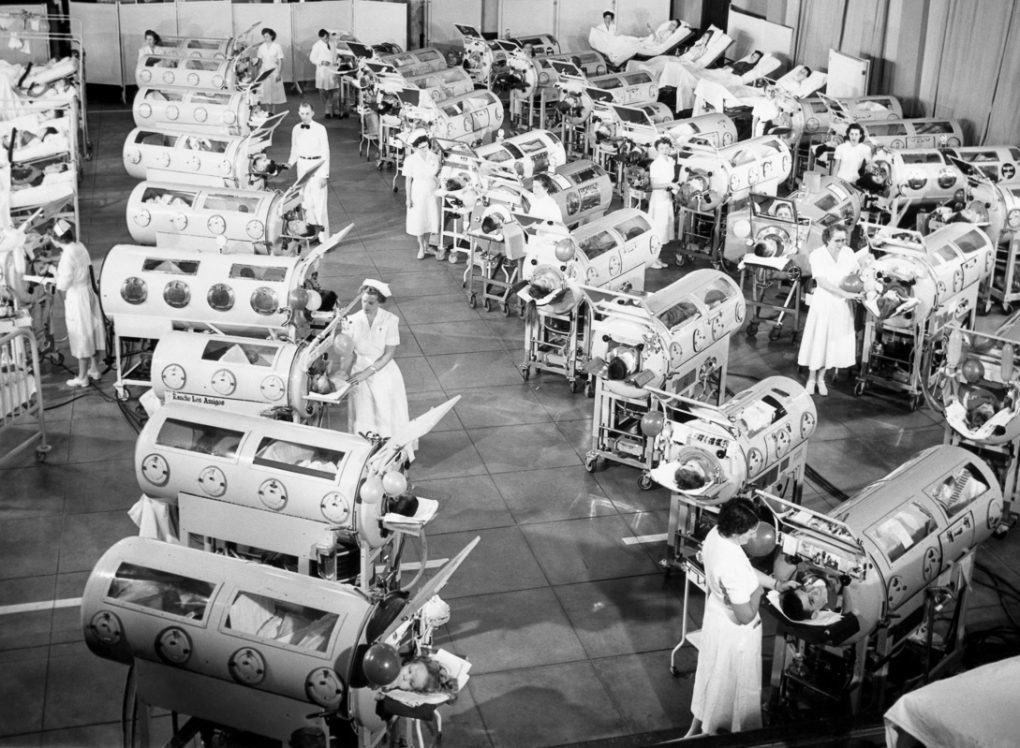
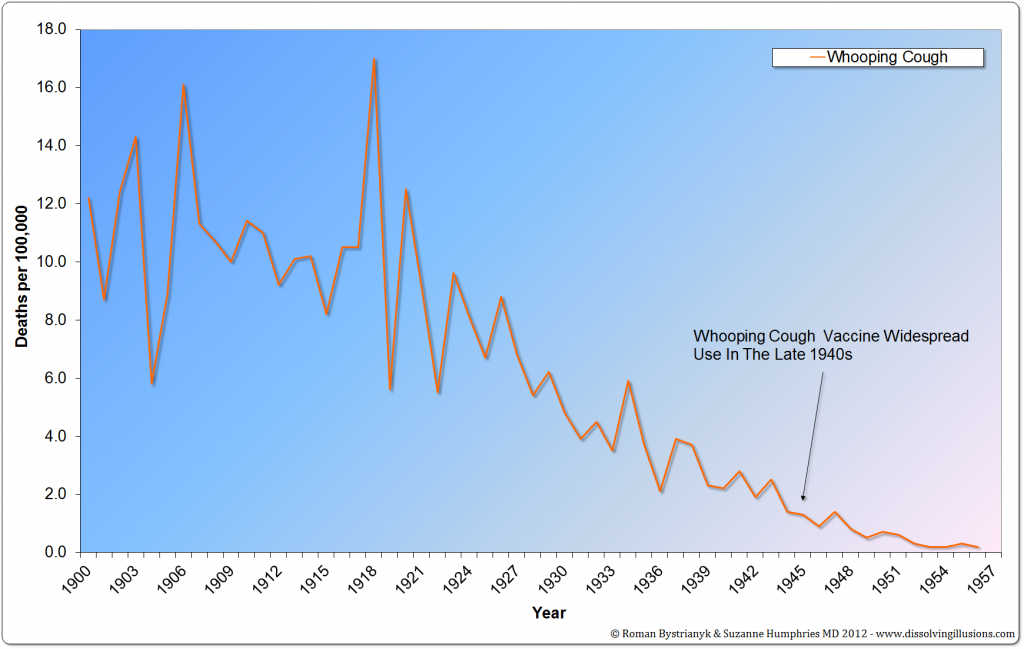
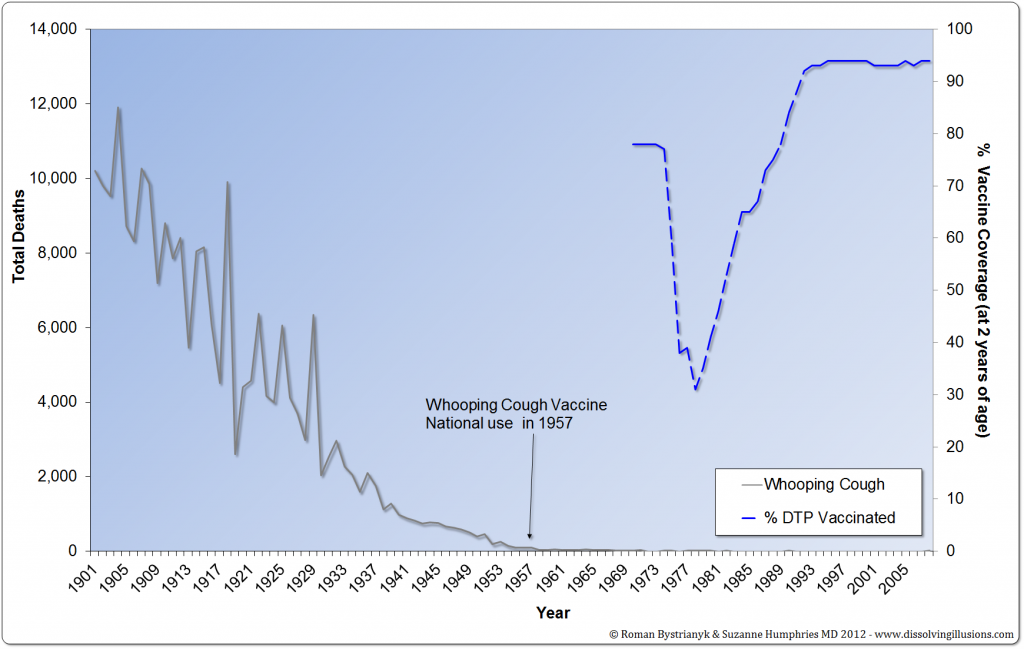
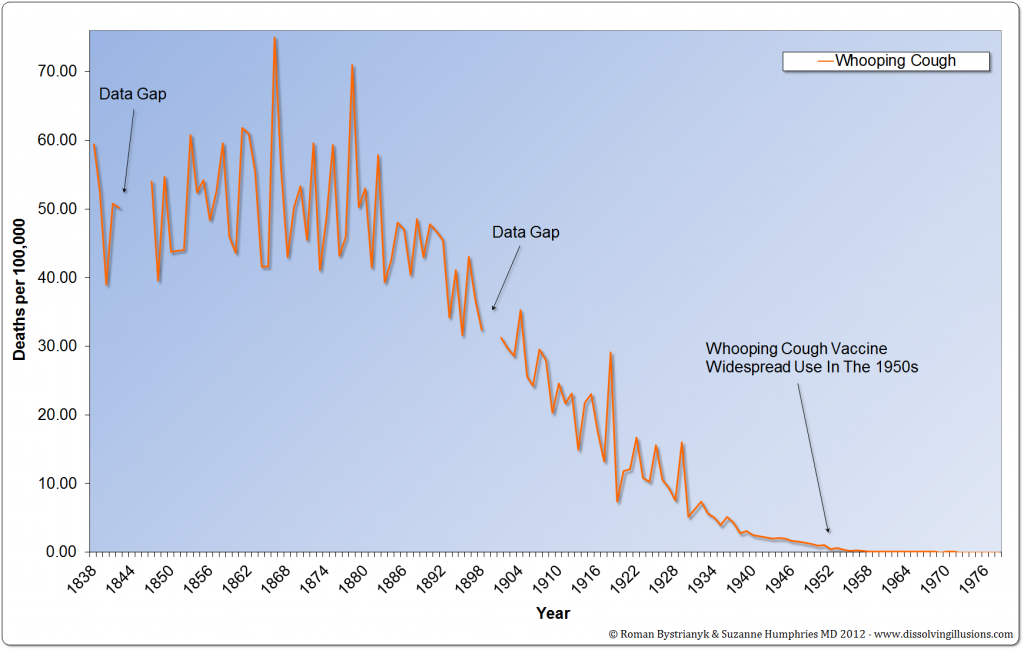
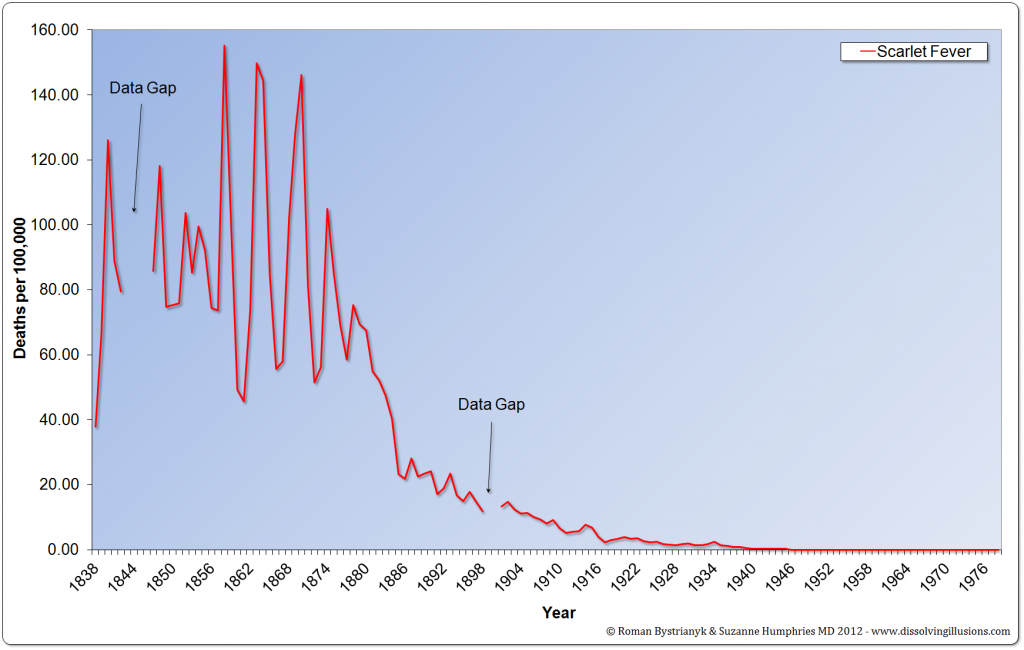



Comment: Be aware: The forgotten history of vaccinations